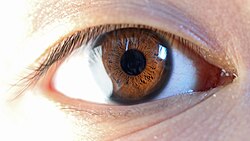
Back Visuelles System ALS جهاز الرؤية Arabic Görmə sistemi Azerbaijani দর্শন ইন্দ্রিয় Bengali/Bangla Sistema visual Catalan Zrakový systém Czech Visuelles System German Vida sistemo Esperanto Sistema visual Spanish Ikusmen-sistema Basque
| Visual system | |
|---|---|
 The visual system includes the eyes, the connecting pathways through to the visual cortex and other parts of the brain (human system shown). | |
 | |
| Identifiers | |
| FMA | 7191 |
| Anatomical terminology | |
The visual system is the physiological basis of visual perception (the ability to detect and process light). The system detects, transduces and interprets information concerning light within the visible range to construct an image and build a mental model of the surrounding environment. The visual system is associated with the eye and functionally divided into the optical system (including cornea and lens) and the neural system (including the retina and visual cortex).
The visual system performs a number of complex tasks based on the image forming functionality of the eye, including the formation of monocular images, the neural mechanisms underlying stereopsis and assessment of distances to (depth perception) and between objects, motion perception, pattern recognition, accurate motor coordination under visual guidance, and colour vision. Together, these facilitate higher order tasks, such as object identification. The neuropsychological side of visual information processing is known as visual perception, an abnormality of which is called visual impairment, and a complete absence of which is called blindness. The visual system also has several non-image forming visual functions, independent of visual perception, including the pupillary light reflex and circadian photoentrainment.
This article describes the human visual system, which is representative of mammalian vision, and to a lesser extent the vertebrate visual system.
© MMXXIII Rich X Search. We shall prevail. All rights reserved. Rich X Search